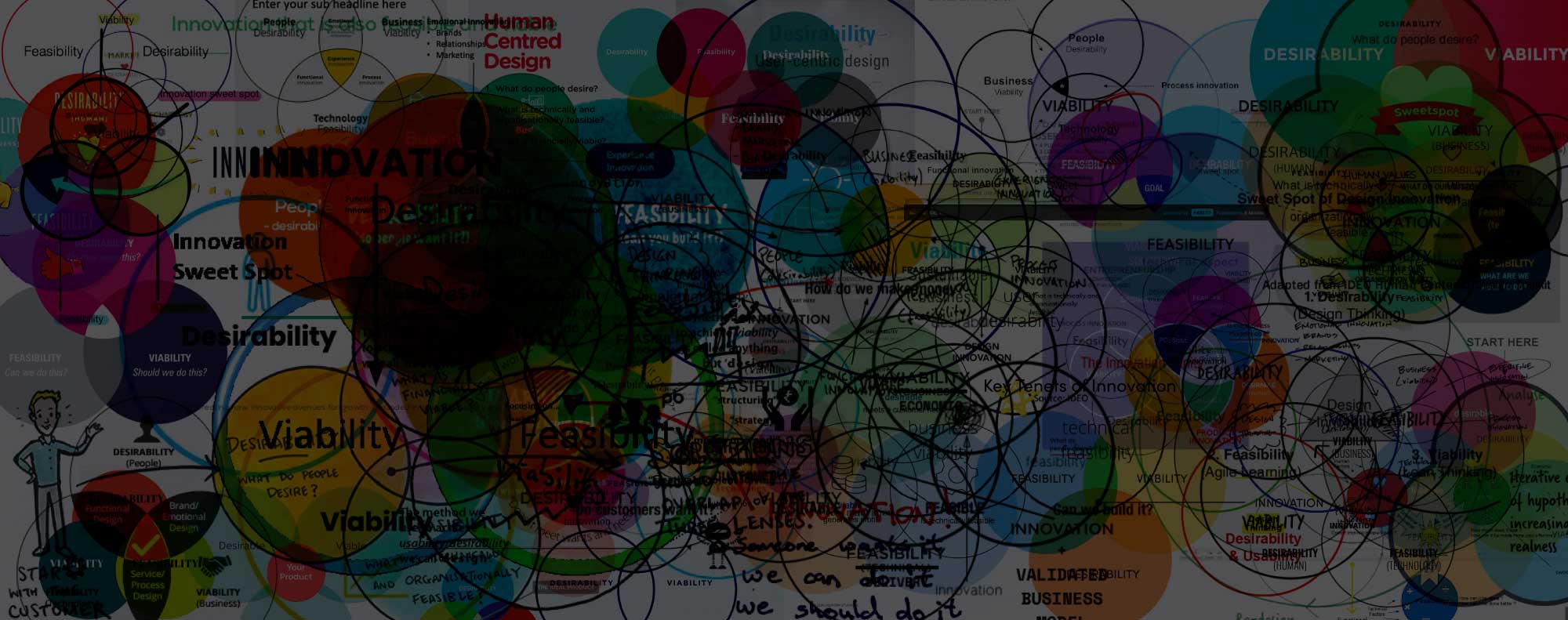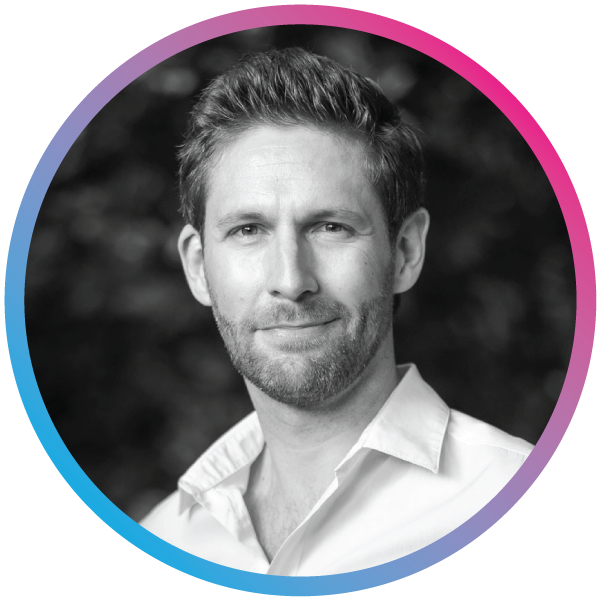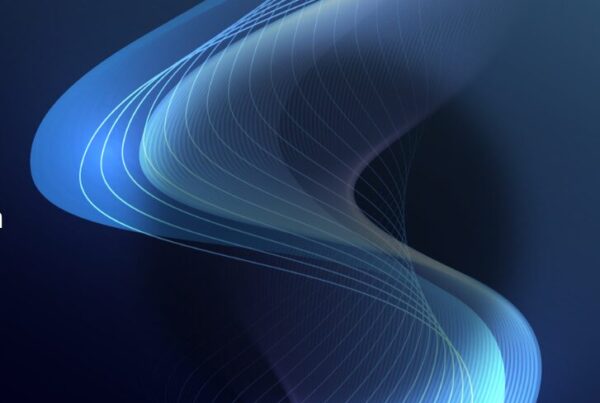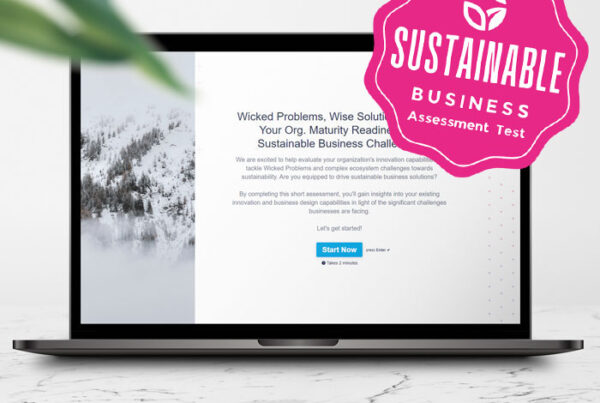The desirability, viability, feasibility Venn diagram is everywhere when it comes to innovation and new business design. It has been useful in explaining the logical order to run the innovation process, but it is time we put it behind us. We need to evolve the field. We have bigger issues than merely solving customer needs and problems.
By the end of this article you will understand how and why existing innovation process and logic prevents us from addressing the most pressing challenges of our time.
Key Learnings from this Article
- Understand why desirability, viability, feasibility model restricts and constrains our thinking about the bigger systemic issues and grand challenges we face today.
- See how key to solving our biggest challenges is reframing the logic of the innovation process itself, so it serves us better and more effectively.
- Discover how broadening innovation across people, planet, profit and purpose, we use innovation to firmly support tackling sustainable business issues, UN SDG’s, the climate crisis and much more.
Desirability, viability, feasibility origins
T he desirability, viability, feasibility diagram was originally developed to help explain the design thinking approach, which is primarily concerned with putting the customer or user at the center of the innovation process. In the mid-2000’s this was a big deal, particularly when large corporates were in the midst of trying to figure out how and why tiny, nimble start-ups could disrupt and displace large corporates and incumbents of old, by exploring new digital technologies, finding unserved customer needs and exploiting disruptive business models.
”Most critically, design thinking keeps people at the center of every process. A human-centered designer knows that as long as you stay focused on the people you're designing for—and listen to them directly—you can arrive at optimal solutions that meet their needs.
Tim BrownIDEO
Tim was right to a degree. You can arrive at optimal solutions that meet their needs, but that is exactly the limiting problem today for innovation, as we shall see.
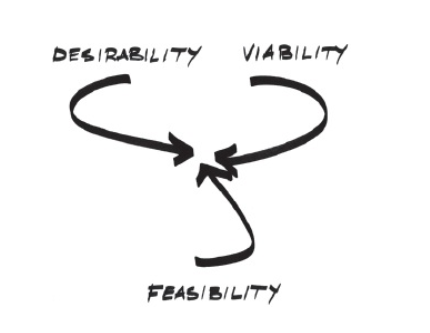
Tim Brown’s original Desirability, Viability, Feasibility triad.
This simple sketch has since gone truly global across intrapreneurial organizations of all types in all industries.
From here, Tim’s company, IDEO transformed it into a Venn diagram to show how combining each of the three core elements, creates what is referred to as ‘the innovation sweet spot’. As the logic goes, by focusing on customers, then the business case, then the technology = optimal innovation outcomes by decreasing the overall levels of risk.
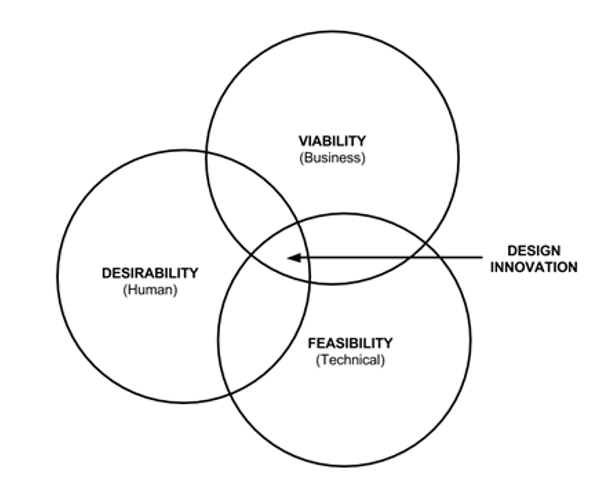
The beauty and simplicity of the diagram aided widespread adoption as the core logic to the innovation processes and its methodologies for the past 12+ years.
1. Customer perspective
Service designers, human centered designers (HCD), user experience designers (UX) and marketing teams (and others) could finally lead the innovation process by uncovering unmet needs, framing challenges, ideating broadly and developing prototypes to test with stakeholders, long before anyone got near a spread sheet or fancy new technology. The innovation process could be sufficiently de-risked, by ensuring the right problems were being solved with evidence data to support decision making.
2. Business perspective
Conversely, business managers could understand that there was no point in developing ‘business plans’ ahead of time for extreme uncertainty projects. They understood there was no need to create a complex, unrealistic business case (Excel theatre), if there were no customers who wanted a proposed solution in the first place.
3. Technology perspective
Engineering or R&D focused teams could quickly grasp that it was essential to first understand the needs and problems of customers and users, before developing costly technologies that nobody wanted.
Venn Diagrams Galore!
A quick Google search for ‘desirability, viability, feasibility’ produces over 800,000+ results of Venn diagram in all colours, flavours and variants to simply visualizing the logic to innovation.
Desirability, viability, feasibility thinking is dominant within innovation, but limits our thinking and possible ecosystem level outcomes.
The model implies if you follow a simple three-step sequential process, successful innovation pops out. As we all know this is not what innovation is, nor how it actually functions in reality.
The desirability, viability, feasibility model has been adopted because it is overly abstract and simple to understand by teams. It is easy to explain how and why customers should be considered first, then figure out the business model, then figure out the technology to enable it.
It has been useful as we transitioned from prescriptive management practices of the late 20th Century to reframe our business value creating logic.
It was particularly useful to help navigate the rapidly-shifting value landscapes caused by the democratizing impact of digital technology on business.
Poll of innovation professionals
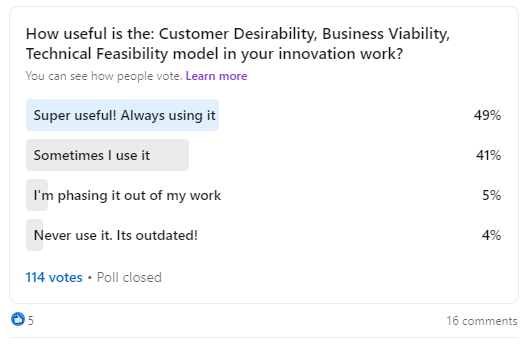
LinkedIn survey poll on usage of the desirability, viability, feasibility innovation model.
A recent LinkedIn survey poll, asked over 100+ innovation professionals how useful they found the desirability, viability, feasibility model in their day-to-day innovation work. Interestingly, this demonstrates how well-engrained the logic and approach is today, with over 90% voting in favor of using it. While anecdotal, this demonstrates the strong pervasiveness of the model in supporting today’s thinking and practice of innovation management.
Underpinning Innovation Logic
The simplicity and high level of abstraction of the model meant it sits above all other innovation methodologies, from Design Thinking, Lean Startup, Design Sprints, Business Model Innovation and Agile to name a few. All innovation methodologies neatly fit under customer desirability, business model, viability and technical feasibility as an integrated process to enable knowing across the innovation process.
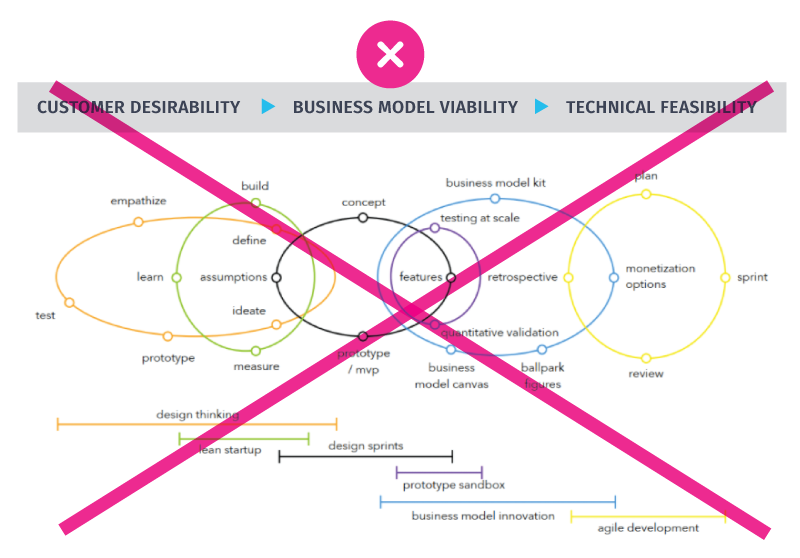
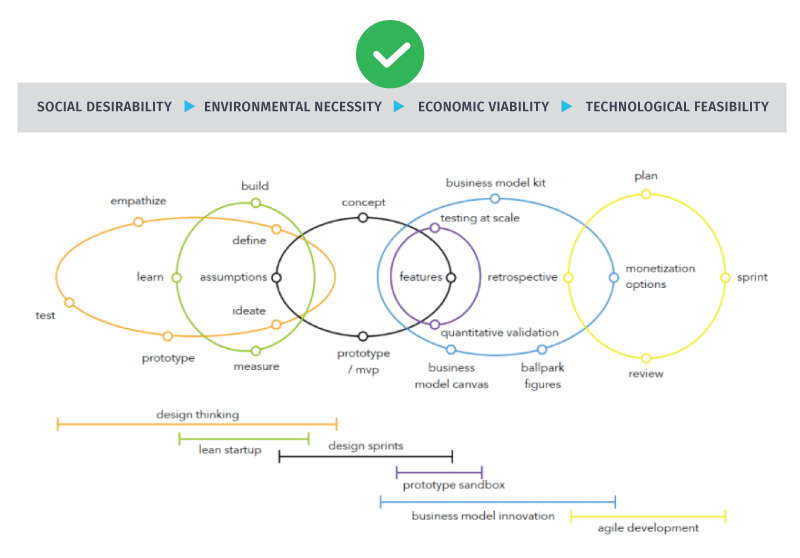
We need to reframe our thinking away from desirability, viability, feasibility models in order to serve our systemic needs and problems better.
So Why is this a Problem?
You surely guessed it. We have much bigger problems to deal with than just satisfying unmet needs and problems of customers and users alone. By focusing on customer centricity as the starting point to innovation, we miss-out on environmental issues, sustainability challenges and circularity and more. These are not simple customer centric problems. They are grand challenges and wicked problems and they don’t neatly reside within a target market or customer segment for research.
We need to break away from the dominant logic of customer centric innovation thinking alone. We need to move towards deeper understanding of ecosystem level challenges, systems thinking, networks of actors and customer stakeholder groups.
Design thinking and customers centric research methods are not currently optimized to deal with this level of complexity early on in the innovation process.
1. Company’s Still Trying to be Customer Centric
A large number of firms have made the transition to more customer-centric, design thinking and lean based innovation processes. They have developed an outward facing view of the world to aid the transition towards digitalization. They can systematically bring-in knowledge and insights from outside company walls to develop and launch successful innovation on demand. However, there are many more companies who have yet to make a customer-centric transition.
The frontiers are once again shifting as business responds to new external challenges, shifting consumer preferences and wider environmental needs. Firms yet to make even a customer-centric shift are set to be left entirely behind.
2. Creative Destruction and Pro-Innovation Bias
The desirability, viability, feasibility model is entirely devoid of the impact of innovation itself, through creative destruction on our world.
Schumpeter defined creative destruction as the ‘process of industrial mutation that continuously revolutionizes the economic structure from within, incessantly destroying the old one, incessantly creating the new one’. Put simply, innovation creates stuff and destroys stuff at the same time.
We have a natural tendency and cognitive bias towards thinking innovation is generally good for us, society and the planet. The more we do it, the better-off we’ll all be. We clearly know this is not the case. Human progress through the application of innovation is directly responsible for the state of our planet and supporting ecosystems.
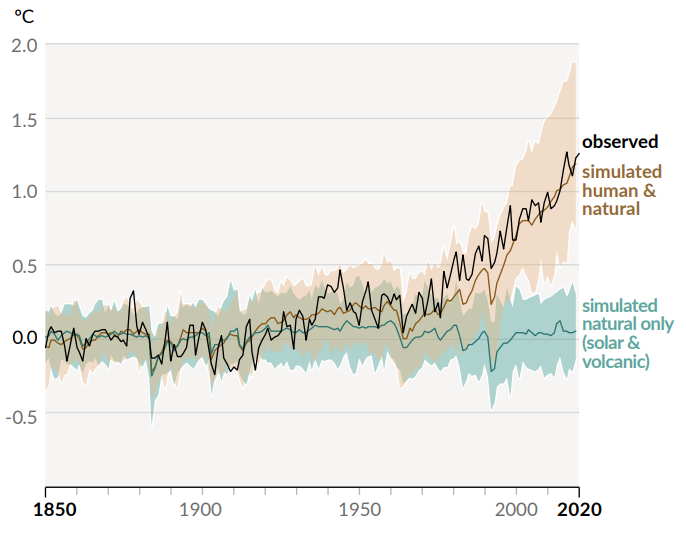
Human influence has warmed the climate. Change in average global temperatures relative to 1850-2000+ showing observed temperatures and computer simulations (IPCC, 2021).
We are now witnessing a transition to the what is termed the Anthropocene, where human activities have directly impacted the environment and climate since the industrial revolution to such an extent that we have now brought about a distinct geological epoch by our own doing.
To put in perspective, the previous epoch began 11,700 years ago after the last ice age. Innovation can benefit us tremendously, but it can equally destroy us and our environment in the blink of a geological eye if left un-checked.
3. Moving Beyond Desirability, Viability, Feasibility
We must address the challenges of this entirely new, self-created geological epoch. We can’t simply solve these problems and challenges by empathizing with the needs and problems of our most valued consumers, customers and users. If we continue to do so, the future does not look good for us, because we won’t be solving the wider issues.
We need to upgrade our thinking, approach, tools, methods and mindset to address complex grand challenges, ecosystem level issues and wicked problems. A good place to start is by reframing how we fundamentally think about the logic of doing innovation.
So let’s get rid of the customer desirability, business model viability, technical feasibility approach and replace it with something that serves our collective needs better.
Upgrading Our Conceptual Model of Innovation
The innovation process typically starts from the customer desirability perspective. Both problem-fit and solution-fit phases are there to ensure a painful enough problem is being solved with a solution that wow’s potential buyers.
When solving grand challenges and wicked problems the Planet, not customer component is often the required starting point. The problems here are known, tangible and ready to start exploring and solving.
The Sustainable Innovation Model
In light of our systemic challenges, needs and problems, the innovation process can (and sometimes should) start from a Planet (environmental necessity) perspective. In this instance customer or social desirability then precedes it.
The reason for this is because the environmental solutions are required first, and we have to adapt our social behaviours as a result. Furthermore, we must include the Planet with full consideration of the intended and unintended consequences of our innovation actions as environmental necessity, not nice-to-haves.
Once People (social desirability) and Planet (environmental necessity) elements have been addressed across problem and solution-fit phases, it then makes sense to explore the Profit (economic viability) aspects of the proposed innovation concepts. Here, all types of value across People, Planet, Profit can be explored through network value mapping techniques in order to tease out critical assumptions for experiment design to test and (in)validate through to scaling.
Once the Profit business model has been validated across stakeholder ecosystems, the Progress (technological feasibility) element can then be considered. New enabling technologies can be seen as a toolkit of ways in which radical ideas and new disruptive business models can be explored and exploited.
Reframing the Innovation Process
When framed across People, Planet, Profit, Progress, we liberate our thinking about the innovation process away from merely considering customer needs and problems to validate desirability before transitioning to business modelling and technological implementation.
By including Planet (ecosystem desirability) as standard practice, we provide an additional starting point for the innovation process and we also provide a crucial sanity checkpoint, to assess the impact of our innovation efforts upon wider outcomes like UN Sustainable Development Goals.
The Future of Innovation Practice
It is hoped this Sustainable Innovation Model (People, Planet, Profit, Progress) inspires others to re-think how their innovation processes are designed, executed and run with better consideration for the wider challenges we face.
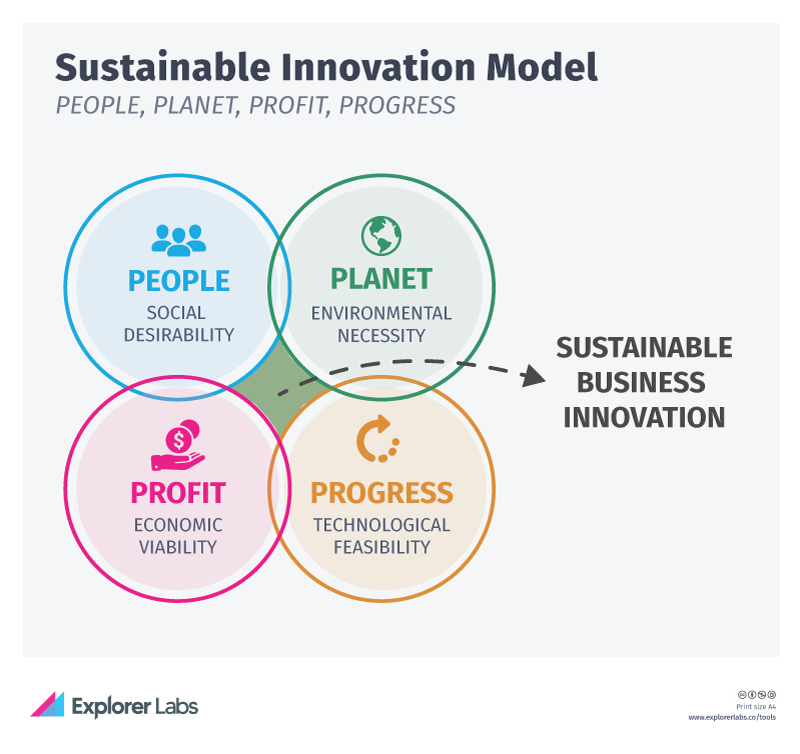
People, Planet, Profit, Progress thinking is needed to underpin the future innovation processes so we solve bigger problems than just customer needs.
By upgrading our thinking in this way, we can design betters, tools, methods and approaches to enable innovation teams to better address and solve the most pressing environmental and ecosystem level issues of our time (as well as including those of end customers!).
Combined in this way we transition our innovation logic away from the infamous innovation sweet spot, towards: sustainable business innovation.
Key takeaways
When working on innovation projects, designing innovation process or developing toolkits and methodologies, make sure to think more broadly than just your end-customer needs and problems perspectives.
- Limiting your innovation strategy to just solving unmet customer needs is a necessary step for today’s business, but it is short-term thinking for tomorrow’s environmental needs. Your innovation strategy and supporting processes must include People, Planet, Profit and Progress in equal measures in order to help contribute to solving our wider challenges and issues ahead.
- Limiting your innovation strategy to just solving unmet customer needs is a necessary step for today’s business, but it is short-term thinking for tomorrow’s environmental needs.
- Make sure to redesign your innovation processes to include all four elements. Your projects in the future may initiate from a Planet or People perspective. Appropriate tools, methods and approaches will be needed to help uncover, synthesize and define the right challenge spaces. Problem-fit and solution-fit will be at both the ecosystem and customer market segment levels in the future.
Future of Innovation Poster
Inspire your innovation teams to think beyond the limits of existing innovation approaches. Stick up this poster in your Miro boards or on the wall to trigger a critical discussion during workshops and meetings.
Grab the poster!Mike Pinder is a cross-industry business innovation expert & consultant, thought leader, author, lecturer & international keynote speaker on innovation. He’s driven by using innovation to leave the world a better place than we found it. Mike is a co-founder of Wicked Acceleration Labs (an industry-academia research lab aimed at tackling wicked problems), Member of Board of Advisors at Global Innovation Institute (GInI), & Honorary Practice Fellow at Imperial College London Business School.
Mike consults and leads across innovation strategy, Design Thinking, Lean Start-up, Business Model Innovation in both B2B and B2C, guiding c-level innovation strategy, innovation accelerator design, co-creation, capability programs, academic research, executive education (Exec Ed) university program design, intrapreneurship, digital transformation, sprints & more.
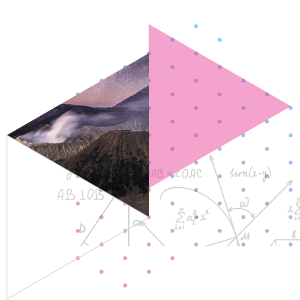
Let’s talk!
Reach out below
We’ll discuss your specific sustainable business-innovation challenges and what to do about them
References
- Brown, T. (2008) IDEO Design Thinking | IDEO | Design Thinking. Available at: https://designthinking.ideo.com/ (Accessed: 25 October 2021).
- Birkhofer, J. and Kloberdanz, H. (2005) ‘An extensive and detailed view of the application of design methods and methodology in industry’, in INTERNATIONAL CONFERENCE ON ENGINEERING DESIGN. Melbourne.
- IPCC (2021) Climate Change 2021: The Physical Science Basis Summary for Policymakers. Available at: https://www.ipcc.ch/report/ar6/wg1/downloads/report/IPCC_AR6_WGI_SPM.pdf.
- National Geographic (2019) Anthropocene | National Geographic Society. Available at: https://www.nationalgeographic.org/encyclopedia/anthropocene/ (Accessed: 25 October 2021).
- Pinder, M. (2019) ‘Applying Service Design While “Innovating like a Start-up”. The role of service design in global Fortune 500 project teams.’, Touchpoint, 11(1), pp. 14–19. Available at: https://www.service-design-network.org/touchpoint/vol-11-no1-service-design-for-innovation-and-start-ups/applying-service-design-while-innovating-like-a-start-up.
- Shukman, D. (2021) Climate change: Sir David Attenborough in ‘act now’ warning – BBC News, BBC News. Available at: https://www.bbc.com/news/science-environment-59039485 (Accessed: 26 October 2021).


